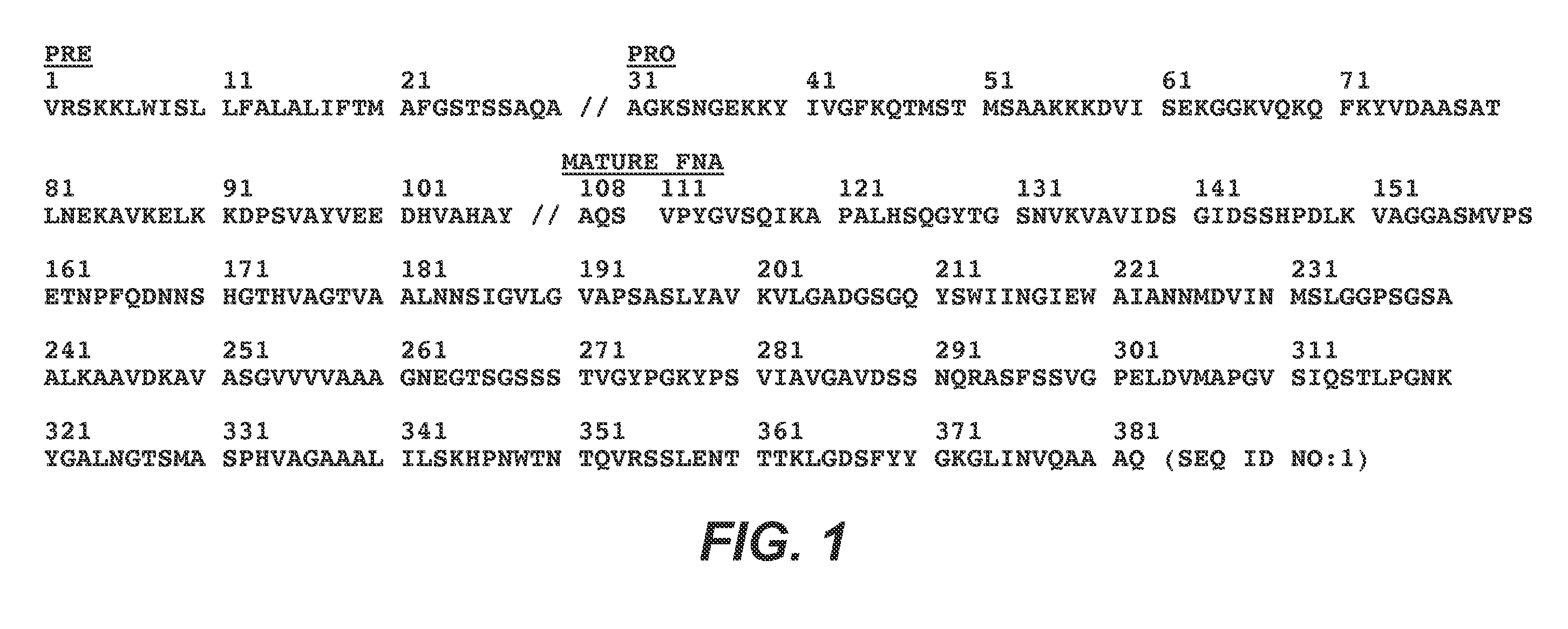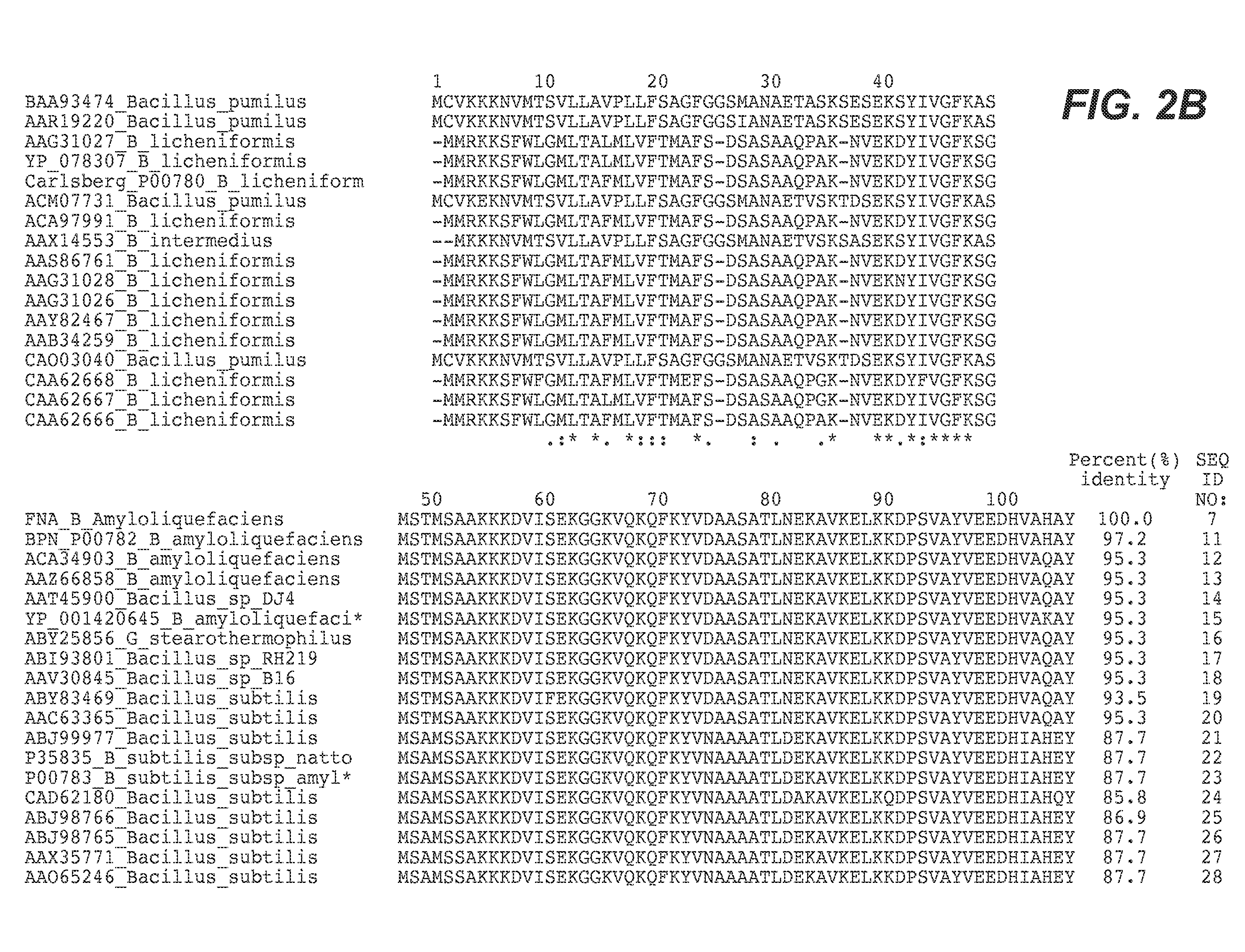Proteases With Modified Pre-Pro Regions
- Summary
- Abstract
- Description
- Claims
- Application Information
AI Technical Summary
Benefits of technology
Problems solved by technology
Method used
Image
Examples
example 1
Targeted ISD (Insertion Substitution Deletion) Library Construction
[0126]The method used to create a library of modified FNA polynucleotides is outlined in FIG. 2 (ISD method). Two sets of oligonucleotides that evenly covered the FNA gene sequence coding for the pre-pro region (SEQ ID NO:7) of a full-length protein of 392 amino acids (SEQ ID NO:1), in both forward and reverse direction were used to amplify the left and right segments of the portion of the FNA gene that encodes the pre-pro region of FNA. Two PCR reactions (left and right segments) contained either the 5′ forward or the 3′ reverse gene sequence flanking oligonucleotides each in combination with the corresponding opposite priming oligonucleotides. The left fragments were amplified using a single forward primer containing an EcoRI site (P3233, TTATTGTCTCATGAGCGGATAC; SEQ ID NO:123) and reverse primers P3301r-P3404r each containing Eam104I site (SEQ ID NOS:124-227; TABLE 1). The right fragments were amplified using a sin...
example 2
Generation of Mutated Pre-Pro Polypeptides Comprising a Combination of Mutations Generated by ISD
[0135]To determine the effect of combining at least two mutations in the pre-pro FNA sequence, combinations of the mutations given in Table 3 were made as follows.
[0136]The pAC-FNA10 plasmid DNAs comprising a mutant from Table 3 was used as a template for extension PCR to add another mutation also selected from mutations described in Table 3. Two PCR reactions (left and right segments) contained either the 5′ forward or the 3′ reverse gene sequence flanking oligonucleotides each in combination with the corresponding oppositely priming oligonucleotides. The left fragments were amplified using a single forward primer (P3234, ACCCAACTGATCTTCAGCATC; SEQ ID NO:411) and reverse primers for the particular mutation shown in Table D. The right fragments were amplified using a single reverse primer (P3242, ACCGTCAGCACCGAGAACTT; SEQ ID NO:412) and forward primers for that particular mutation shown ...
example 3
[0141]Site Evaluation Libraries (SELs) were constructed to generate positional libraries at each of the first 103 amino acid positions that comprise the pre-pro region of FNA. Site saturation mutagenesis of the pre-pro sequence of the full-length FNA protease was performed to identify amino acid substitutions that increase the production of FNA by a bacterial host cell.
SEL Library Construction
[0142]Pre-Pro-FNA SEL production was performed by DNA 2.0 (Menlo Park, Calif.) using their technology platform for gene optimization, gene synthesis and library generation under proprietary DNA 2.0 know how and / or intellectual property. The pAC-FNA10 plasmid containing the full-length FNA polynucleotide (GTGAGAAGCAAAAAATTGTGGATCAGTTTGCTGTTTGCTTTAGCGTTAATCTTTACGATGGCGTT CGGCAGCACATCCAGCGCGCAGGCGGCAGGGAAATCAAACGGGGAAAAGAAATATATTGTCGG GTTTAAACAGACAATGAGCACGATGAGCGCCGCTAAGAAGAAAGATGTCATTTCTGAAAAAGGC GGGAAAGTGCAAAAGCAATTCAAATATGTAGACGCAGCTTCAGCTACATTAAACGAAAAAGCTGT AAAAGAATTGAAAAAAGACCCGAGCGTCGCTTAC...
PUM
| Property | Measurement | Unit |
|---|---|---|
| Fraction | aaaaa | aaaaa |
| Temperature | aaaaa | aaaaa |
| Fraction | aaaaa | aaaaa |
Abstract
Description
Claims
Application Information
 Login to View More
Login to View More - R&D
- Intellectual Property
- Life Sciences
- Materials
- Tech Scout
- Unparalleled Data Quality
- Higher Quality Content
- 60% Fewer Hallucinations
Browse by: Latest US Patents, China's latest patents, Technical Efficacy Thesaurus, Application Domain, Technology Topic, Popular Technical Reports.
© 2025 PatSnap. All rights reserved.Legal|Privacy policy|Modern Slavery Act Transparency Statement|Sitemap|About US| Contact US: help@patsnap.com



